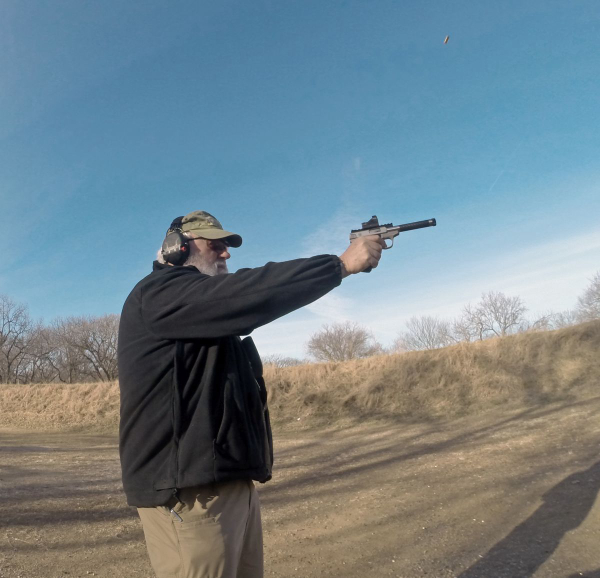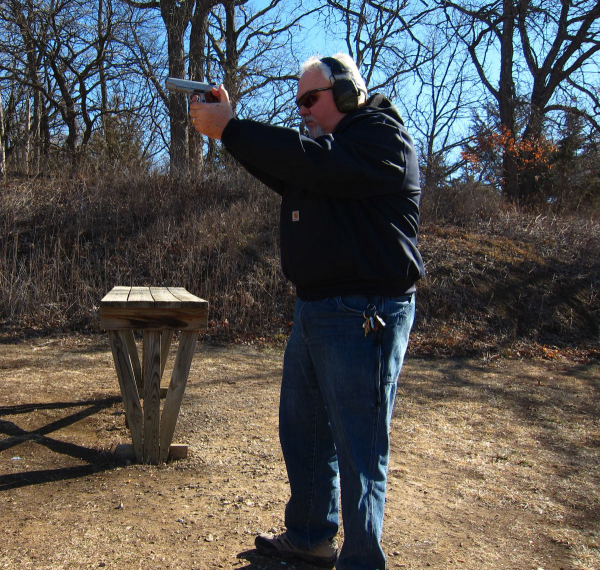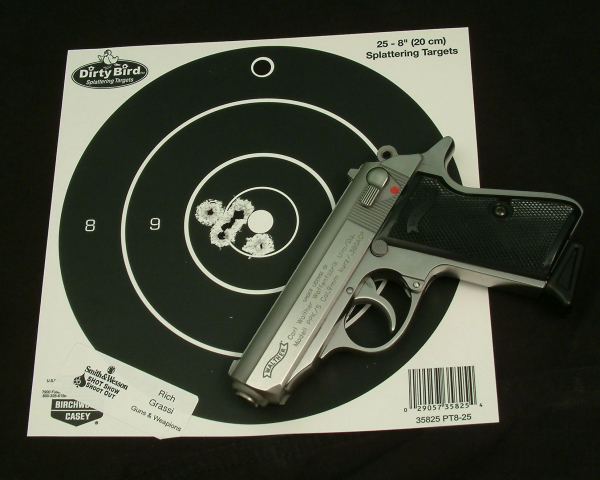In 2005, after shooting guns since the mid-1960s, I was at a media event the day before SHOT Show commenced. At an indoor range, Smith & Wesson had media types shooting the guns they were offering that year and offered a bit of a contest – smallest group size wins the Smith & Wesson-Walther PPK/S 380.

Regardless of shooting one-handed or two-, finding your natural point of aim before firing will help get a consistent result on target.
I’d been at another event earlier and my shooting was disastrous. A friend, more a mentor I’d acquired on previous trips to SHOT Show, addressed me about my shooting – in much the same way a member of service sought to help me in 1983 during a run-up to police firearms instructor school.
That peace officer in that case later left the agency, returning to his home state, taking up law enforcement again – and getting killed in the line of duty. That was on my mind as Doc O’Meara approached me.
Retired Chief Petty Officer Robert H. O'Meara was “author of three books and hundreds of articles published in outdoors magazines in the US, France, Germany and Australia.” He’d been a career Navy Corpsman and did six years as a deputy sheriff.
He’d seen me struggling on the line and said something to me about “natural point of aim” – except it was hell for loud in an indoor range. Once we got off the range deck, he repeated himself and said to remember – natural point of aim.
What is that? In rough terms, it’s “addressing the ball,” it’s “settling on the mound” and “stepping up to the plate.” When you are involved in “sustained fire” (for bullseye, that’s timed and rapid fire), where do the sights go after recoil? And can you predict it?

To find the NPOA, move your feet and reassess. For me, I find the NPOA is more squared up to the target; for others, a more bladed approach helps. Reassess often. Sometimes you’ll move out of your natural point.
Natural point of aim. When you take a shooting position and get the okay for dry practice and aiming in, you’ll aim in on the target, await the natural respiratory pause, then close your eyes. When you open your eyes, where are the sights – relative to the target? If they’re generally where you left them, you’ve found your natural point of aim.
If not, you don’t move the gun, your hands, arms, torso – you adjust with your feet. Careful, a little movement goes a long way. Once you accomplish that – the sights are “on” when you open your eyes -- you made it. You’ve achieved skeletal support so you don’t have to use muscular tension to hold the gun on the middle of the target. It’s a good thing to have, but it’s fleeting.
It’s something you will have to reacquire. As near as I can recall, it’s explained this way --
If you simply aim in at a target without everything being in place consistently and accurately time after time, you’ll find yourself “muscling” the gun onto the target. That’s not a good plan. While sights confirm the location in which the muzzle is directed, holding them there and having them fall back into the bull shot-after-shot is difficult.
If it’s a situation where guns have to be holstered or benched, and I can’t aim the gun in dry, I’ll use my thumb to “aim in.” It’s a coarse reference, but I’ve used it with some success.
After Doc reminded me, that is.
It’s so much easier to keep the rounds clustered together when the relaxed-yet-stable stance, reinforced by skeletal structure rather than tensioned in by use of muscles, drops the dot or the sights right back at the home position.
The strain of using muscles to keep the gun aimed in can increase that “wobble zone,” the area of movement you see the sights making over the target.
The way I do it now is stolen from the SIG Academy in their video here – almost. Instead of “windshield wiper,” I generally “paint the fence;” aimed in, I close my eyes when I hit the respiratory pause and I move the muzzle laterally like the video, but only across the face of the repair center.
Otherwise, bystanders figure I’m having a stroke. I’ll never be a champion, but I don’t need to make the process tougher. I’ll use the advantage of technique to make my meager skills better.

Winning isn't everything. It’s remembering someone who helped you over helping themselves that really sticks with you.
There in Las Vegas 20 years ago, I took the good Doctor’s advice. When it was my turn, I faced the target – it was around thirty feet away, I believe. My first job was to aim in, then relax and close my eyes. Opening my eyes, I saw that I was off. I had to move my left foot more in line with the right and tried again. It was good.
After that, I fired the group pictured here.
It won and I got the gun.
The most valuable gift was the well-intentioned advice from someone else competing for the same gun. But that’s the way he was – and that’s the memory I kept.
— Rich Grassi